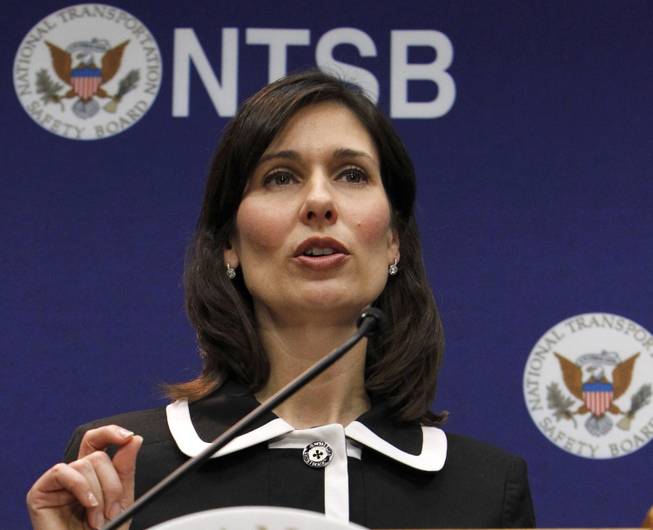
Ann Heisenfelt / AP
In this Feb. 7, 2013, file photo, National Transportation Safety Board Chair Deborah Hersman speaks during a news conference in Washington.
Tuesday, May 14, 2013 | 10:11 a.m.
WASHINGTON — Federal accident investigators recommended Tuesday that states cut their threshold for drunken driving by nearly half, matching a standard that has substantially reduced highway deaths in other countries.
The National Transportation Safety Board said states should shrink the standard from the current .08 blood alcohol content to .05 as part of a series of recommendations aimed at reducing alcohol-related highway deaths.
More than 100 countries have adopted the .05 alcohol content standard or lower, according to a report by the board's staff. In Europe, the share of traffic deaths attributable to drunken driving was reduced by more than half within 10 years after the standard was dropped.
A woman weighing less than 120 pounds can reach .05 after just one drink, studies show. A man weighing up to 160 pounds reaches .05 after two drinks.
New approaches are needed to combat drunken driving, which claims the lives of more than a third of the 30,000 people killed each year on U.S highways — a level of carnage that that has remained stubbornly consistent for the past decade and a half, the board said.
"Our goal is to get to zero deaths because each alcohol-impaired death is preventable," NTSB Chairman Deborah Hersman said. "Alcohol-impaired deaths are not accidents, they are crimes. They can and should be prevented. The tools exist. What is needed is the will."
But the recommendation to lowering the alcohol content threshold to .05 is likely to meet strong resistance from states, said Jonathan Adkins, an official with the Governors Highway Safety Association, which represents state highway safety offices.
"It was very difficult to get .08 in most states so lowering it again won't be popular," Adkins said. "The focus in the states is on high (blood alcohol content) offenders as well as repeat offenders. We expect industry will also be very vocal about keeping the limit at .08."
The lower alcohol content threshold was one of nearly 20 recommendations aimed at reducing drunken driving made by the board, including that states adopt measures to ensure more widespread use of use of alcohol ignition interlock devices. Those require a driver to breathe into a tube, much like the breathalyzers police ask suspected drunken drivers to use.
The board has previously recommended states require all convicted drunken drivers install the interlock devices in their vehicles as a condition to resume driving. Currently, 17 states and two California counties require all convicted drivers use the devices.
However, only about a quarter of drivers ordered to use the devices actually end up doing so, NTSB said. Drivers use a variety of ways to evade using the devices, including claiming they won't drive at all or don't own a vehicle and therefore don't need the devices, staff said.
The board recommended the National Highway Safety Administration, which makes safety grants to states, develop a program to encourage states to ensure all convicted drivers actually use the devices. The board also recommended that all suspected drunken drivers whose licenses are confiscated by police be required to install interlocks as a condition of getting their licenses reinstated even though they haven't yet been convicted of a crime.
Courts usually require drivers to pay for the devices, which cost about $50 to $100 to buy plus a $50 a month fee to operate, staff said.
The board has previously called on the safety administration and the auto industry to step up their research into technology for use in all vehicles that can detect whether a driver has elevated blood alcohol without the driver breathing into a tube or taking any other action. Drivers with elevated levels would be unable to start their cars.
But the technology is still years away.
Studies show more than 4 million people a year in the U.S. drive while intoxicated, but about half of the intoxicated drivers stopped by police escape detection, the NTSB report said. The board made several recommendations aimed at increasing both the visibility and effectiveness of police enforcement, including expanded use of passive alcohol devices. The devices are often contained in real flash lights or shaped to look like a cellphone that officers wear on their shirt pockets or belts. If an officer points the flashlight at a driver or the cellphone-like device comes in close proximity to an intoxicated driver, the devices will alert police who may not have any other reason to suspected drunken driving.
The use of the devices currently is very limited, the report said.
Dramatic progress was made in the 1980s through the mid-1990s after the minimum drinking age was raised to 21 and the legally-allowable maximum level of drivers' blood alcohol content was lowered to .08, the report said. Today, drunken driving claims about 10,000 lives a year, down from over 18,000 in 1982. At that time, alcohol-related fatalities accounted for about 40 percent of highway deaths.

Join the Discussion:
Check this out for a full explanation of our conversion to the LiveFyre commenting system and instructions on how to sign up for an account.
Full comments policy